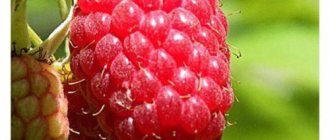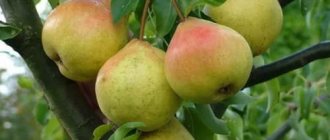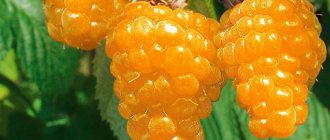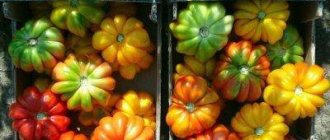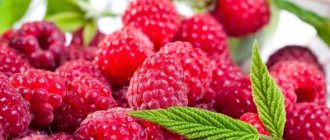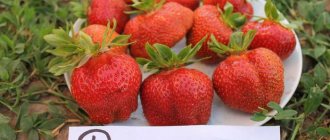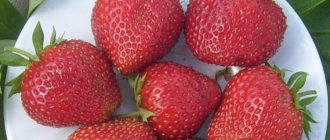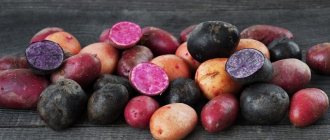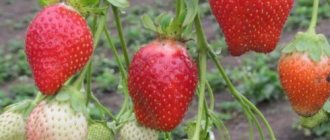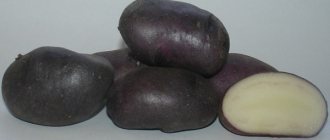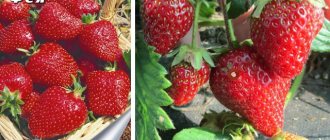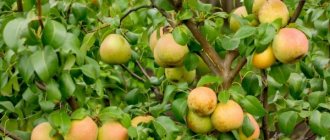The Autumn Beauty raspberry is considered an excellent variety. The plants are remontant, mid-ripening, and bear berries for a long period of time. Caring for the crop is easy. It produces fruit in abundance. Also, it takes root well in the south of the country. Due to the early spring and long warm autumn, you can get berries from two harvest waves.
Raspberries were bred by scientific breeders Kulagina, Evdokimenko, led by Kazakov. Academician Kazakov worked on culture for 40 years. He created 20 varieties. All work was carried out within the walls of the Kokinsky strong point.
AGRO PREMIUM is an innovative, environmentally friendly plant activator, without chemicals, that protects berries, fruits and vegetables from pests and diseases, increases seed germination, stimulates root formation and plant growth, and significantly increases productivity.
Autumn beauty, like “Firebird”, “Bryansk Miracle”, “Ruby Necklace”, “Hercules” can be planted in the middle regions of the country. She is usually interested in small farms and amateur gardeners. Due to the extended period of fruiting, the berry can be used for a long time.
Characteristics of the raspberry variety Autumn Beauty
The bushes are one meter in diameter. Height from 1.1 to 1.3 m. Plants with strong and highly branched stems. The root zones contain many shoots. The branches are long and fruitful.
Remontant raspberries grow in the middle regions, in the Moscow region. Thornless autumn beauty. Therefore, care and picking of berries is easy.
As for the characteristics of the fruits, they are from 4 to 5 g.
The fruits are large, ruby-red in color, and have a round-conical structure. They have a good sweetness, along with a rich, pleasant aroma. You can find many duplicate copies. These are genetic consequences. The berries can remain on the stems for a long time. They don't crumble. They are torn off the stalks without effort.
When purchasing seedlings, always evaluate their characteristic features, regarding winter hardiness, attitude to pests, etc.
Raspberry Autumn beauty takes weather conditions calmly. The stems are not frozen because they are completely cut off at the end of the autumn season. Roots are not afraid of cold weather. Raspberries are prepared for winter using mulching:
- manure;
- humus;
- straw.
This is the main protection against freezing.
a brief description of
Like any plant, the Autumn Beauty raspberry has its pros and cons, but their presence should in no way scare professionals or novice gardeners, because the result is amazingly tasty berries.
Advantages of the variety
- Complete pruning of shoots in the fall allows you to reduce the time it takes to protect the raspberry tree from frost. If you mulch the soil well, then the likelihood of the roots, rather than the stems, freezing is practically zero;
- Autumn beauty is not susceptible to diseases and various pests;
- Unlike many other remontant varieties, this variety produces quite a lot of root shoots, which allows you to quickly grow a raspberry tree to the desired size.
Disadvantages of the variety
- Remontant raspberries are more demanding in terms of compliance with agricultural technology. She has to be fed more often with various nutritional complexes;
- Some gardeners write in their reviews that the berries of Autumn Beauty are not as sweet as their summer “colleagues” due to too hot weather. This happens because cooler weather slows down the metabolism in the bushes, which is why nutrients and minerals do not reach the fruits in full.
What harvests does the Autumn Beauty raspberry produce and how does it bear fruit?
Remontant plants were bred in three groups.
They include:
- to the early ones;
- late;
- mid-season.
Autumn beauty was sent to the second group. The first wave is collected in mid-August. Then, gradual ripening, until the last days of September. From 5 to 7 kg are collected from one plant.
If you picked branches with unripe berries in late autumn, place them in water in your living room and they will become ripe.
The largest harvests occur in mid-September. Usually from the 10th to the 15th.
Description of the variety
The plant is medium-sized from one and a half to two meters, quite compact, does not produce a lot of root shoots. There are about five root shoots per season. However, the shoot-forming ability is sufficient. Forms up to 11 replacement shoots per bush. Without thorns, tall, tall, thickened, flexible, strong, and unbreakable when bent. On the stems you can notice a slight pubescence and a waxy coating.
Characteristic of the variety are elongated fruits and tall stems with large leaves.
The shoots on which the berry is formed are powerful branches with about 20 fruits. With abundant and proper feeding, a larger number of berries can be born on the bush. It is not for nothing that this variety is called a heavyweight among large-fruited raspberries. The fact is that the weight of one berry can reach 12 grams. The smallest fruit weight is 4 grams. But basically this is an exception to the rule, since the Beauty of Russia produces an abundant and good harvest. With high agricultural technology, the berry is large and very large by the standards of breeders.
By the way, the parent varieties of Krasa Rossii: Maroseyka and Mirage have been observed at the Breeding Institute for at least 15 years. Their best qualities are distinguished by: productivity (up to 20 berries per shoot from Maroseyka!), unpretentiousness and large-fruitedness of both varieties, as well as the bright and thick smell of forest raspberries (from Mirage). Disadvantages include: genetic instability. That is, root suckers do not always produce fruits as large and abundant as the mother bushes. Crossing two varieties made it possible to correct this shortcoming. This is how the Beauty of Russia appeared.
The shape of the fruit is conical, regular, elongated. The color is rich crimson or bright red, without intense gloss. Along the entire length of the stem there are corrugated leaves, dark green in the middle and downwards, light green at the crown of the flowers.
This raspberry has a medium ripening period, produces at least 5–6 harvests per season, and is not remontant. Krasa Rossii bears fruit from early July to mid-August, and sometimes longer. Since it produces a harvest for a long time, and the berries are heavy, the average yield of the Krasa Rossii variety is above the norm, rare for raspberries, and abundant. Flowering occurs simultaneously at different times of summer (in waves), the flowers are very large, unusual for ordinary varieties.
The fruits are universal: suitable for both fresh dietary nutrition and canning and long-term storage.
Harvest from Krasa Rossii can be harvested up to six times per season
The taste is dessert, sweet, pronounced, and has a high tasting score (4.7 out of 5). It is distinguished by a gentle sourness, adding piquancy to the bouquet of taste. There are not many seeds, the berries are juicy, dense, aromatic.
Advantages and disadvantages of the variety
The beauty of Russia has such positive qualities as:
- Productivity
- Large fruit
- Moderate winter hardiness (up to minus 26 degrees)
- Drought resistance (the berries do not dry in the sun, do not bake)
- Genetic stability (does not degenerate)
- High taste qualities
- Resistance to typical fungal and viral crop diseases
Flaws:
- In bad weather conditions and improper care, it is susceptible to chlorosis, leaf mosaic, brown spotting of stems and gray rot.
- Requires shelter for the winter (due to icing and broken branches) and garters to a trellis net, since the stems are tall and powerful
- Even slightly overripe large berries do not tolerate transportation; they are stored for literally several hours!
Many gardeners mistakenly claim that the Beauty of Russia does not have a rich sweet taste, as well as a bright aroma. This is wrong. The variety was bred with emphatically high taste and aromatic qualities. Most likely, it has to do with the soil in which the berry bushes grew. The lack of microelements negatively affects the sugar content of fruits. It is worth thinking about fertilizers after rains and snow melting, since it is at this time that many useful substances are washed out of the soil.
What are the advantages and disadvantages
Do not forget that the Autumn Beauty raspberry needs to be groomed and it will thank you with its responsiveness. Thanks to a good agricultural background, you will always have good harvests.
And besides productivity:
- winter-hardy;
- drought-resistant;
- with prolonged fruiting;
- without thorns;
- does not fall off;
- does not dry out in sunlight;
- moderately produces root shoots.
But:
- without trellises it will not be able to withstand the weight of the berries;
- will not survive without fertilizing, heat, humidity, light.
- gardeners rated the taste 4 points.
Important!
Remontant culture does not reproduce easily. Reluctantly gives out offspring. Because it directs all its energy to the development of stems and berries.
To get more harvest, you need to select the right places and plant according to agrotechnical laws. Plantings are done in such a way that the bushes do not provide shade to each other.
Reviews from gardeners
Alexander, 38 years old, Tula
I spent a long time choosing raspberries to plant on my plot. After studying the descriptions of varieties, photos and reviews, the Autumn Beauty raspberry caught my interest in the first place. I purchased seedlings from a local nursery and planted them in the garden in the fall. The bushes have grown to 1.2 m in height, they are quite spreading, with a girth of up to 1 m. The berries are tasty and aromatic, ripening at the end of July.
Maria, 47 years old, Moscow region
Autumn Beauty learned about raspberries from a neighbor who highly praised this variety. Raspberries deserve attention; they are one of the best varieties in terms of taste. According to the description and photo, the Autumn Beauty raspberry variety bears quite large fruits. The berries are inferior in size to Hercules or Ruby Necklace, but the variety wins in terms of yield. I always tie up the bushes, otherwise they will bend under the weight of the harvest. The shoots are strewn with berries, I collect them before frost. After picking, the fruits often crumble into drupes; the variety is not suitable for long-term storage.
Olga, 24 years old, Ufa
Raspberries are one of the healthiest berries. I have long wanted to plant a remontant variety to harvest all summer. I chose the Autumn Beauty raspberry based on the description of the variety, photos and reviews. Seedlings were ordered from an online store and received by mail. The variety pleases with good taste and productivity. Enough for both jam and sale. I try not to overcrowd the plants, so I get one abundant harvest in the fall.
How to choose suitable places
Try to keep Autumn Beauty always light and surrounded by fertile soil.
These are the demands she makes:
- protection from the north wind;
- not shaded areas;
- fertilizers
Be sure to flavor:
- humus;
- vegetable compost;
- high peat, per 1 m2 from 2 to 3 buckets of organic matter.
All together with complex elements (“Kemira universal”, “Growth”), or mineral ones in the form of:
- superphosphate;
- potassium sulfate.
You can simply fertilize with ash and organic matter.
Raspberries will develop well after:
- green manure (white mustard, lupine, phacelia);
- eggplant;
- tomatoes;
- potatoes.
Planting raspberries Autumn beauty
Use rows or nests for planting Autumn Beauty raspberries. Planting holes are dug with a distance of 0.7 m from each other. Between rows from 2 to 2.5 m. The earth is dug up with a depth of 25 to 35 cm.
Perennial weeds are weeded along with their roots. Fertilizers are applied. Then holes 30 x 35 cm (depth x width) or planting grooves are dug.
All root collars must be at ground level. Then there will be no problems with the development of shoots.
Adhere to the norm for deepening the root collars. So that the formation of stems begins on time. And make sure that they do not stick out and prevent summer damping and winter freezing.
Does this variety really exist?
The most authoritative source of information about varieties is the website of the Russian Federation State Commission for Testing and Protection of Breeding Achievements. “Fairy tales” are not on his list of raspberry varieties. Therefore, officially this variety does not exist.
The raspberries sold by sellers as the standard variety “Skazka” are, at best, a derivative of the Tartus variety, and do not have strictly defined varietal characteristics. In the worst case, under the guise of advertised raspberries, gardeners are sold any seedlings. Unofficially, the variety continues to exist. Time will tell how durable he is.
How to care further
Feed, water regularly, mulch and Autumn Beauty raspberries will give you delicious berries in large quantities.
Feed:
- mullein 1:10 in early July;
- nitrogen fertilizers in the first halves of June-July;
- mineral fats, with phosphorus, potassium, microelements, in the 2nd half of July-August.
The rhizomes of plants are close to the surface, so they need to be watered regularly, but without stagnating water. If this happens, the small suction roots will die off.
Loosen the ground as carefully as possible. 1 m in diameter from the centers of the plants and with a depth of up to 5 cm inclusive. Mulch the soil (peat, humus).
For summer green work, your actions such as:
- pruning excess or weak growth;
- work to remove root shoots.
Important!
Leave 3 to 6 strong raspberry stems per 1 m2
The Autumn Beauty is tied up twice. When the stems reach a height of 30 cm. And when they reach 1 m.
- When the first autumn frosts arrive, then all above-ground parts of the plants are cut off.
- Then the raspberries are cleaned.
- And everything ends with moisture-discharge irrigation.
How to deal with diseases and pests, preventive measures
Autumn Beauty raspberries can be affected by raspberry beetles if they are adjacent to regular raspberries. While the crop has not yet bloomed, treat the stems with Fitosporin and Agrovertin. These are insecticides.
If you apply a large amount of fertilizers that contain nitrogen, aphids or caterpillars will appear. Use phosphorus, potassium and insecticidal additives. Fight insects:
- "Confidor".
- “Fufaon.”
- “Arrivo.”
Important!
Don't forget about garlic tinctures with laundry soap. Spray raspberry bushes with this tincture after 2 weeks.
Reviews
Gardeners fell in love with these plants because remontant varieties are very different in both care and yield from ordinary raspberry varieties.
Vladislava Miroshnichenko, 45 years old from Astrakhan.
We purchased the Autumn Beauty to generate income from it. Our customers speak very highly of it. She is very popular. We always sell in large volumes. We use chicken manure for fertilizer.
We have 2 rows of bushes. Without a garter, raspberries will feel bad. You have to tie them to trellises with structures like this. All rows have two posts and three rows of wire between these posts.
While the bushes are not blooming, we give the raspberries mullein (solution 1:10). We collect berries in August and September. We prune everything in the fall.
Svetlana Cherednyakova, 40 years old from Stavropol.
Everyone praises these berries. But they didn’t seem very good to me. The taste is kind of watery. We consume them in the fall. But mostly in the summer we eat others. We feed raspberries in early March. For this we use mineral fertilizers. To prevent fungi from growing, we treat it with copper sulfate. One Autumn Beauty bush gives us about 7 kg of berries.
Varieties of late-ripening remontant raspberries
Late raspberry varieties are suitable for cultivation in the southern regions. The fruits ripen at the end of August or even in September. There are not many late varieties of remontant raspberries. The most popular among them are Heritage, Otm Treasure, Morning Dew, Erica, Shugana. Remontant late raspberry Heritage has straight, vigorous shoots. The variety was developed in 1969 as a result of crossing the Durham, Milton and Katberg varieties. Its berries are red, medium in size, dense and do not fall off for a long time. They are easy to remove from the stalk and tolerate transportation well. The taste is good, with a pleasant aroma.
Heritage is a high-yielding variety with average resistance to diseases and pests. Bears fruit from July until frost. Winter hardiness is high.
Otm Treasure was developed in the UK. The variety is vigorous, the shoots are erect and have practically no thorns. The berries are easily removed from the stalk, have an average weight of 3.3-3.5 g. Their shape is elongated-conical, their color is red. The berries of the Otm Trezhe variety tolerate transportation well and are stored better than many summer varieties.
Morning Dew ripens in late summer. The variety was bred by Polish breeders. Bears large yellow fruits weighing 8 g. The taste is sweet and sour.
Erica is a productive variety of Western European selection, one of the best. The berries are large, dark red, shiny and of excellent taste.
The Shugan variety is a mid-late, drought-resistant variety of Swiss selection. The berries are medium-sized, which, with good care of the bush, reach 10 g.
There are many varieties of remontant raspberries. With such diversity, it is easy to ensure a constant harvest throughout the season until the coldest weather. And the better the care of the raspberry tree, the more harvest it will bring.
Raspberry golden autumn
